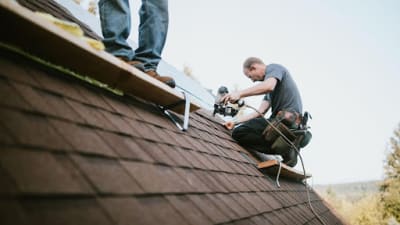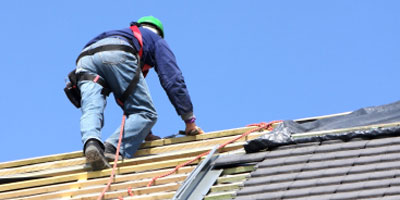Roof Replacement Novi: A Step-by-Step Guide for First-Time Homeowners
Roof Replacement Novi: A Step-by-Step Guide for First-Time Homeowners
Blog Article
Just How Climate Condition Can Influence Your Roof Covering Durability
Your roofing faces continuous obstacles from the weather condition, and it's vital to comprehend just how these conditions can shorten its life-span. Each component plays a function in your roof covering's longevity, but how can you successfully prepare for these threats?
The Effects of UV Rays on Roofing Products
When your roof is subjected to sunlight, those dangerous rays can create considerable damages over time. This destruction deteriorates your roofing system and makes it less reliable at securing your home.
You can minimize these results by picking UV-resistant roof materials or using protective layers. Regular inspections also aid catch very early indications of damages, enabling you to attend to issues before they intensify. Additionally, think about mounting reflective roof covering alternatives that can deflect UV rays and maintain your home colder. By remaining aggressive regarding UV direct exposure, you'll expand the life of your roofing and improve your home's general resilience. Taking these steps currently can conserve you cash and stress and anxiety in the future.
Just How Extreme Rainfall Can Cause Roofing Damage
While UV rays can compromise your roofing system, extreme rains poses an additional substantial threat to its integrity. When hefty rainfalls occur, water can pool on your roofing system, bring about potential leaks and structural damage with time. They can wear away faster than anticipated. if your roofing materials aren't made to deal with long term exposure to wetness.
Clogged gutters can intensify these problems, triggering water to overflow and seep right into your home. You could observe discolorations on your ceilings or wall surfaces, signifying that water is discovering its means inside. Furthermore, standing water can advertise mold and mildew growth, which not just harms your roof but can also influence your indoor air top quality.
To shield your roof, validate your drain systems are clear and functioning correctly. Routine assessments can assist you recognize weak places prior to they become expensive repair work, maintaining your roofing system healthy also during hefty rains.
The Impact of Snow and Ice Buildup
When snow and ice stack up on your roofing, you may not understand the anxiety it places on the structure. That included weight can cause serious problems like roof sagging or also collapse. Plus, ice dam development can catch water, triggering leaks and additional damages to your home.
Snow Lots Anxiety
As winter blankets your home in snow, the weight of built up ice and snow can place considerable stress and anxiety on your roofing system. You could not recognize exactly how swiftly snow can collect, particularly during hefty storms, so it's crucial to maintain an eye on the weight your roof is supporting. Furthermore, understanding your roof's structure and its snow lots rating can inform you concerning when to take action.
Ice Dam Development
Ice dam formation can become a substantial problem throughout winter season, specifically when snow accumulates on your roofing and temperature levels change. When heat leaves from your home, it melts the snow on your roof, creating water to stream down. As this water gets to the colder eaves, it ices up, creating a dam that protects against more drain. In time, this trapped water can seep under roof shingles, resulting in leaks and significant damages to your roofing framework. To stop ice dams, make certain your attic is properly insulated and aerated. You ought to additionally consistently remove snow buildup from your roofing. By taking these safety measures, you'll help extend your roofing's lifespan and stay clear of pricey repair work brought on by ice dam concerns.
Temperature Changes and Their Role in Roof Covering Deterioration
Temperature variations can seriously impact your roof covering's lifespan. As materials broaden and contract with warmth and cool, they come to be more at risk to fractures and damages. Furthermore, freeze-thaw cycles can worsen these issues, leading to additional damage gradually.
Thermal Growth Results
When temperatures change, your roofing system can go through substantial thermal development and tightening, which may result in worldly stress and anxiety and deterioration in time. As the sunlight heats your roof covering throughout the day, products broaden; when temperatures drop at night, they contract. This consistent cycle can create weak spots, particularly at joints and joints. You might discover splits, warping, or loosened shingles consequently. These problems can lead to leakages and expensive fixings if left unattended. To minimize damages, take into consideration utilizing roof covering products developed to hold up against these temperature adjustments. Normal inspections can also help you catch very early indicators of wear, ensuring your roofing system stays resilient and efficient in securing your home.
Freeze-Thaw Cycles
As wintertime sets in, the freeze-thaw cycles can damage your roofing system. Moisture from rain or snow permeates into holes and splits when temperature levels dip. As it freezes, it increases, placing enormous pressure on your roofing products. This cycle repeats as temperatures fluctuate, progressively creating wear and tear. You could see Visit Website roof shingles splitting, crinkling, or even disintegrating over time.
Overlooking these issues can cause more substantial issues, consisting of leakages and architectural damage. To protect your roof, it's important to evaluate it routinely, especially after extreme weather. Addressing small issues quickly can assist extend the life of your roofing, guaranteeing it withstands the harsh impacts of freeze-thaw cycles throughout winter months.
Moisture Degrees and Their Effect on Roofing System Honesty
While many individuals concentrate on temperature changes, moisture levels play a crucial function in identifying the stability of your roof. High moisture can create a damp environment that motivates algae, mildew, and mold and mildew development, every one of which can compromise roofing products in time. If your roofing system's ventilation isn't sufficient, wetness can obtain trapped, resulting in timber rot and other architectural issues.
Conversely, low moisture can result in dry conditions, causing products like roof shingles to come to be breakable and split. This brittleness can make them a lot more at risk to damage from other weather elements.
To preserve your roof's stability, it is necessary to keep track of humidity levels and assure correct air flow. Routine assessments and upkeep can help recognize possible issues prior to they end up being significant issues. Keeping your roof covering in excellent problem indicates being proactive concerning moisture results, ultimately lengthening its lifespan and safeguarding your home.
Wind Damage: A Quiet Risk to Your Roofing
Moisture isn't the only weather condition factor to consider; wind damages can silently endanger your roofing's honesty. Solid winds can lift roof shingles, loosen blinking, and also tear off entire areas of your roof. You may not see these issues promptly, yet in time, they can lead to significant leakages and structural damages.
If you live in a location vulnerable to high winds, it is necessary to maintain an eye on your roof covering after storms. Evaluate for any type of missing out on or damaged tiles and check the sides where the roofing satisfies other surfaces. Siding Contractor. Take note of any debris that might have accumulated, as this can trap moisture and worsen damage
Disregarding these indications may save you time currently, however it can cost you extra over time. An aggressive approach to wind damages can aid assure your roof covering continues to be strong and safe, extending its life expectancy and safeguarding your home.
Preparing Your Roof for Extreme Weather Occasions
When preparing your roof for extreme climate occasions, it's critical to assess its current condition and make necessary upgrades. Beginning by inspecting for missing out on or damaged roof shingles, as these click for source can cause leaks throughout heavy rainfall or snow. Change any kind of compromised products to guarantee a solid foundation.
Next, inspect the flashing around vents, skylights, and smokeshafts. Correctly sealed blinking stops water from permeating in, which can create considerable damages.
Consider strengthening your roof covering's framework, particularly if your area is vulnerable to high winds or hefty snowfall. Installing impact-resistant roof shingles can include an added layer of security.
Ultimately, clear seamless gutters and downspouts to promote proper water drainage. Clogged up gutters can cause ice dams or roof leakages. By taking these proactive steps, you'll help expand your roof's life expectancy and lessen possible damages throughout severe weather condition occasions.

Regularly Asked Questions
Exactly how Typically Should I Evaluate My Roof Covering for Climate Damages?

Can I Fix Roof Covering Damage Triggered By Weather Myself?
Yes, you can fix roof damage triggered by weather on your own if you have the navigate to this website right tools and abilities. Simply ensure you prioritize security, evaluate the damages thoroughly, and follow correct fixing methods to prevent future issues.
What Roof Covering Products Are Finest for Extreme Climate?
For severe weather condition, think about steel, slate, or impact-resistant roof shingles. These products hold up against heavy winds, hail storm, and snow better than others. You'll guarantee your roofing lasts longer, securing your home from harsh components efficiently.
How Does Environment Change Affect Roofing Durability?
Climate adjustment accelerates use on your roof, causing materials to deteriorate much faster. Enhanced temperatures and serious tornados can result in more frequent repairs. You'll need to contemplate resistant alternatives to assure your roofing system lasts longer.
Should I Consider a Roof Guarantee for Weather-Related Issues?
Yes, you should most definitely consider a roof covering guarantee for weather-related issues. It shields you against unpredicted damages, ensuring your investment continues to be safe. Plus, it gives assurance during unpredictable weather.
Just How Extreme Rain Can Lead to Roof Covering Damages
When hefty rains occur, water can merge on your roof, leading to possible leakages and architectural damages over time.Humidity isn't the only climate element to consider; wind damages can quietly threaten your roof's stability. By taking these proactive steps, you'll assist extend your roof's life-span and minimize prospective damage during extreme weather events.
Can I Fix Roofing Damage Triggered by Climate Myself?
Report this page